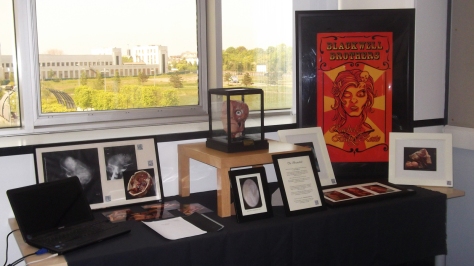I must apologise, as I have been rather remiss in updating this blog. There isn’t that much to say, but for the sake of closure it should be done (even if it is 18months late!)
_
Sadly, the exhibition never did occur – but I did manage to get a photo when I had most of the materials together as a trial run..
As you can see the brainchild artefact makes up the centre piece, and is surrounded by various media. This method of transmedia storytelling allows us to weave the [fictitious] tale of The Brainchild from a variety of perspectives. Layered up and pieced together they reveal a much more elaborate truth lying behind the façade of a sideshow attraction.
The printed media included old photographs, medical documents and x-rays, a carnival poster, and close-up photographs of the exhibit itself. The laptop displayed a digital timeline which showed the chronological history of item. There were also two large screens present, showing us the story from the perspective from the showman and his victim respectively.
Screenshot of the digital timeline:
First video:
Second video:
_














